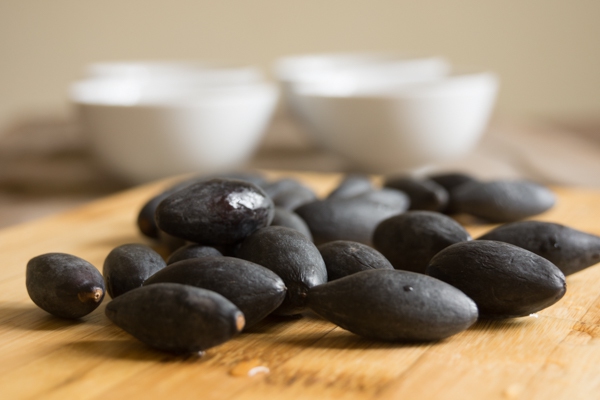Black and White Ebony: A Tasty Treat
Ebony fruits, also known as Son Lam, Cam Lam, Gian Qua, and Thanh Qua in traditional Vietnamese medicine, are a delicious treat with a unique, nutty flavor. There are two main types: black ebony and white ebony (also known as green ebony), with some sources mentioning a third variety, the pink ebony. The black ebony, in particular, has two subtypes: ‘tram chim’ and ‘tram trau’, distinguished by their shape, with one being round and short with less flesh, while the other is longer and more generously fleshed.
1. Selecting, Preparing, and Storing Black Ebony:
When choosing black ebony, opt for fruits that are long and tapered at both ends, feeling firm to the touch with a smooth, powdery skin free of wrinkles or blisters. Upon purchasing, spread them out in a cool, well-ventilated area. Ebony fruits are highly susceptible to moisture; keeping them in a sealed plastic bag will cause them to soften and rot.
To prepare the fruits for consumption, they must be thoroughly washed and rubbed against each other and a trellis to release their resin. Repeat this process 5-7 times until the fruits are clean and the water runs clear.

2. Cooking and Preserving Black Ebony
Cooking ebony fruits is a delicate process. To achieve the perfect texture, maintain a water temperature of around 60 degrees Celsius, adding a pinch of salt. Soak the prepared fruits in this water for about 30 minutes, keeping them in a relatively warm place. The ideal temperature range for cooking ebony is between 55 and 62 degrees Celsius; above 70 degrees, the fruits harden and become astringent, while temperatures below 50 degrees result in undercooked or less flavorful fruits.

Once cooked, ebony fruits can be stored in a slightly salty, hot brine and refrigerated to last up to a week. Alternatively, they can be canned, similar to making jam.
Ebony Fruit Delicacies
Ebony fruits are incredibly versatile and can be used in a variety of dishes. White ebony is commonly made into jams, dried fruits, or used in fish and meat stews, while black ebony is often cooked with meat or stuffed and steamed. However, the most popular way to enjoy ebony is simply by eating the cooked fruits as they are.
Black ebony, with its rich, buttery texture and subtle aroma, pairs exceptionally well with savory dips. Try it with a dip made from minced meat, fried shallots, and spices, or indulge in the classic combination of fatty pork belly, herbs, star fruit, and shrimp paste.

Ebony season is fleeting, so don’t miss out on the opportunity to treat yourself and your family to these unique, tasty fruits. We hope you found these tips on preparing and preserving ebony fruits useful!






























